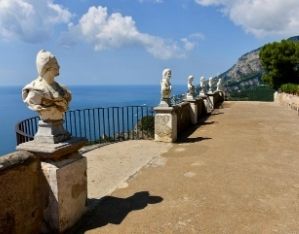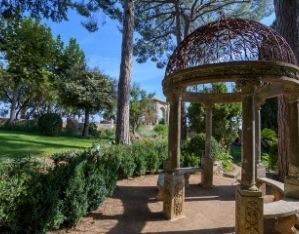On an Amalfi Coast promontory overlooking the sea, along with Villa Rufolo, Villa Cimbrone is one of the world’s most impressive gardens ever created by an Englishman outside of England.
The story of this garden began in 1904, when Ernest William Beckett, later Lord Grimthorpe, bought an old country house on the Cimbrone promontory and converted it into a romantic English castle by adding elements inspired by Mediterranean architecture. He carried through the underlying theme of the inextricable relationship between Englishness and the Mediterranean character to the gardens too. The large park was designed hand-in-glove with the house and the site’s spectacular characteristics. A central throughway connects the entrance with the Temple of Ceres, dividing the garden into two areas, each of which has its own distinctive features. The area to the east, which opens onto the countryside, is sunny and planted with wild flowering gardens; the green space becomes more natural as you move away from the house, until it finally blends in with the countryside and woodland. The area to the west has a shadier feel to it, with winding paths connecting hillocks and small temples populated by portrayals of mythological figures and authentic/copied archaeological finds. A formal garden model was adopted both for the Rose Garden and the garden in front of the Tea Room. In contrast, a landscaping approach is evident along the edges of the gardens, where the dense vegetation opens up partial views of the coastline. The garden’s rich botanical heritage takes advantage of espaliers and flowering rooms typical of Gertrude Jekyll-style gardens. Villa Cimbrone fully expresses the cultural climate of the early decades of the century, when it was a meeting place for European intellectuals including Forster, Keynes, Strackey, and Lawrence, and when its rooms hosted Vita Sackville-West and, perhaps, Virginia and Leonard Woolf, the last of the prestigious travellers to embark on the Grand Tour tradition.




